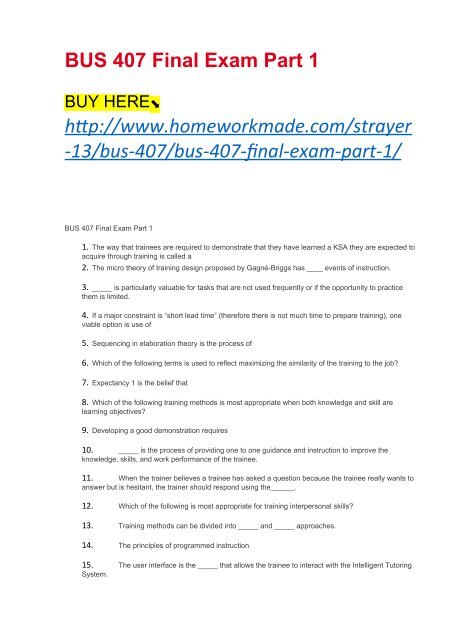BUS 407 Final Exam Part 1
Create successful ePaper yourself
Turn your PDF publications into a flip-book with our unique Google optimized e-Paper software.
<strong>BUS</strong> <strong>407</strong> <strong>Final</strong> <strong>Exam</strong> <strong>Part</strong> 1<br />
BUY HERE⬊<br />
htp://www.homeworkmade.com/strayer<br />
-13/bus-<strong>407</strong>/bus-<strong>407</strong>-fnal-exam-part-1/<br />
<strong>BUS</strong> <strong>407</strong> <strong>Final</strong> <strong>Exam</strong> <strong>Part</strong> 1<br />
1. The way that trainees are required to demonstrate that they have learned a KSA they are expected to<br />
acquire through training is called a<br />
2. The micro theory of training design proposed by Gagné-Briggs has ____ events of instruction.<br />
3. _____ is particularly valuable for tasks that are not used frequently or if the opportunity to practice<br />
them is limited.<br />
4. If a major constraint is “short lead time” (therefore there is not much time to prepare training), one<br />
viable option is use of<br />
5. Sequencing in elaboration theory is the process of<br />
6. Which of the following terms is used to reflect maximizing the similarity of the training to the job?<br />
7. Expectancy 1 is the belief that<br />
8. Which of the following training methods is most appropriate when both knowledge and skill are<br />
learning objectives?<br />
9. Developing a good demonstration requires<br />
10. _____ is the process of providing one to one guidance and instruction to improve the<br />
knowledge, skills, and work performance of the trainee.<br />
11. When the trainer believes a trainee has asked a question because the trainee really wants to<br />
answer but is hesitant, the trainer should respond using the______.<br />
12. Which of the following is most appropriate for training interpersonal skills?<br />
13. Training methods can be divided into _____ and _____ approaches.<br />
14. The principles of programmed instruction<br />
15. The user interface is the _____ that allows the trainee to interact with the Intelligent Tutoring<br />
System.
16. The main difference between Virtual Reality and Multimedia training is that in Virtual Reality<br />
training<br />
17. Which of the following statements regarding ET is true?<br />
18. Interactive Multimedia training can be used for<br />
19. In developing an ET program, which three factors need to be considered?<br />
20. The experiential learning model, a process for using games and exercises in training, has<br />
_____steps.<br />
21. Which of the following seating arrangements is most conducive to switching back and forth<br />
between lecturettes and small group activities?<br />
22. The “process” for the developmental phase of the training model is<br />
23. According to the text, the skill component of an effective trainer’s KSAs is comprised of all<br />
BUT which of the following?<br />
24. Good listening skills require practice because<br />
25. Which of the following statements regarding OJT trainers is true?

















